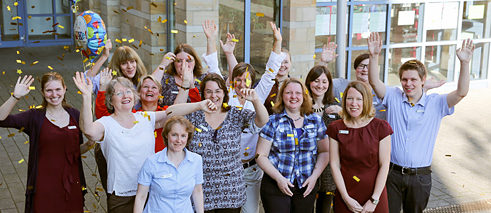Library Marketing
“The library as a ‘third place’ is becoming increasingly important”

Events, social media services and makerspaces: Claudia Büchel, Director of the Hilden City Library, explains in an interview how even smaller libraries can implement targeted marketing.
Mrs. Büchel, in 2016 the Hilden City Library was honored by the German Library Association as the Library of the Year for, among other things, its “innovative marketing concept”. What is the idea behind this?
We try to make decisions on a systematic basis and this includes a marketing concept. First, we did an inventory and looked at where we stand as a library. Hilden has about 56,000 inhabitants. Of these, 8.5 per cent have a library card. We reach children between six and seven years of age very well. Here the collaboration with day-care centers and schools has paid off. It’s important to look at where we want to go and how we can get there. The work with refugees, for instance, has now become a major priority. But we also want to develop the library in other areas. For example, part of our team is working hard on the introduction of makerspace services.
Events and social media
What are the individual building blocks of your marketing concept?The concept starts with an extensive analysis section in which we summarize the changes in the city, the composition of our users and how we can reach the inhabitants of Hilden. Then we define our goals – for instance, the already mentioned makerspace services. Finally, we specify how and by what means we can attain the goals. Marketing tools are, for example, public relations work or cooperation with other institutions.
Is it no longer enough in 2016 for a library to have good media holdings?
The library conceived of purely as a place for lending media is now outdated. The library as a “third place”, next to home, work or school, is becoming increasingly important. We need comfortable seating and free LAN. Event work is also important to feature the library as a meeting place. Our events cover all age groups. For the very young, beginning with six months, there’s already the “ABC Brownie”. Our events concept, which is part of the marketing concept, sets numbers for participants. If actual attendance too often falls short, the series of events will be discontinued. And then I find our work with social media very important in order to be able to communicate directly with our users. We’ve had a Facebook page since 2011. In the following years we started our blog, the “Reading Oasis”, and joined Twitter. In 2015 we added Instagram and, beginning this year, we also send our users information using WhatsApp. On the social platforms our users are particularly interested in a look behind the scenes.
Cooperation and networking
Many libraries, especially smaller ones, complain about budget cuts and lack of staff. Is marketing still possible in these circumstances?The general conditions differ greatly from library to library. But this doesn’t mean that the approach is fundamentally different. Even with fewer resources or poor spatial conditions, you can still try to get the most out of your facility.
You won’t, for example, be able set up a large makerspace in a small library. The resources are too limited.
That’s right. There are, however, opportunities to achieve something through cooperations and incorporating volunteers. Networking is very important at libraries with small budgets. But first I need to know what possibilities the city offers. If, for instance, a library sets up a makerspace, but there already exist comparable services, then that’s rather inauspicious. The key question is in what areas it’s useful to cooperate.
Team meetings and users’ wishes
How did you inspire your staff to work with social media, intensive event planning and other new ideas?We consider in team meetings what our future services should be and each colleague assumes his or her own responsibility. In order to implement the social media services, for instance, we redistributed responsibilities. Specialists in Media and Information Services took on responsibilities that were previously supervised only by librarians. This freed resources so that everyone could work with social media. It was immensely important to bring the team on board and not to decide all this “from the top down”.
And how do you include the users?
We always try to envisage things from the point of view of the user. We have feedback cards on which they can make suggestions for improvements. In thinking up ideas for new services we also first ask the users. Our fiction section, for instance, first asked them whether we should arrange novels alphabetically, according to author, according to theme or according to the interested group. Before we made elaborate rearrangements of our holdings, we approached our users and asked for their views.
A survey conducted by the Allensbach Institute on the future of libraries shows that what 76 per cent of all respondents valued above all in a library is its extensive media offerings. Is marketing overrated?
A library is still primarily linked to the building where its books are. In second place, however, it’s about the events and kind of communication – for example, social media –it offers. In recent years this has become more and more important.
Claudia Büchel has been director of the Hilden City Library since 2009. She studied public librarianship at the University of Cologne and is particularly interested in the public relations, marketing and quality management.